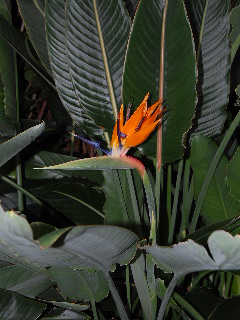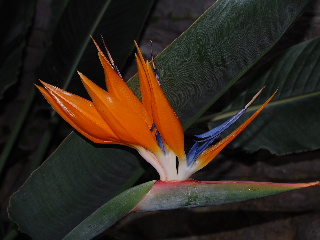
Classic foliage and distinctive blooms make this unique flowering plant an unusual and exciting addition to your home garden.
The bird-of-paradise plant is a member of the banana family (Strelitziaceae) and gets its name from the shape of its colorful flower that resembles a bird’s beak, head, and crown. Some say the flower resembles a bird in flight or the profile of a crane’s head. (Crane flower is another common name for the bird-of-paradise.)
The leaves are large and “tropical-looking” in nature, emanating more from a node than from a trunk and enhancing the island feel and appearance of the plant.
The bird-of-paradise is native to South Africa and needs warm (year-round above freezing) temperatures in order to survive outdoors. However, it can be grown indoors as a large container plant provided it receives adequate sunlight.
Gardeners with strong backs and sunlit patios may want to move the giant potted plant outdoors to add an exotic touch to the deck for the warm summer months.
This unusual plant is not a good one for the impatient gardener to cultivate. It tends to be rather slow growing, anyway, and usually takes two years or more for production of the distinctive flowers to begin.
The bird-of-paradise needs adequate humidity in addition to the aforementioned plentiful sunshine, as well as regular watering (but not to the point of constantly wet soil around the roots) in order to thrive. Also, the plant is a heavy feeder and should be fertilized year-round, more heavily in the summer months.
Over a period of time, your lovingly tended plant may reach heights and spreads of four feet or more. By this time, you should be getting a nice production of colorful blooms.
The flowers of this unusual plant are actually modified leaves (called bracts) that can be up to 8 inches or more in length. The size and coloring of the blooms can vary with plant variety and with the sunlight, humidity, watering, and feeding that we emphasized. Also, in general, the older and larger the plant is, the larger the blooms will be.

At this point in your exotic bird-of-paradise gardening adventure, the question becomes—to re-pot or not to re-pot? Your answer will be based on consideration of several factors.
First of all, some gardeners believe that allowing the plant to become rootbound in its container will actually encourage more blooms. This you can determine by simple observation; are you continuing to get lots of blooms or are the size and number of flowers diminishing?
A second consideration in re-potting is that the divided and re-potted plants will basically be starting out from scratch like new plants—in other words, it may once again be 2 years or more before flowering occurs!
If you do decide to lift and divide your plant, the best time of year for this is in the spring. Be sure you cut the plant in such a way that each section has ample roots (rhizomes) to nurture healthy divisions into vigorous growing stock. Re-pot into good potting soil, water and fertilize with organic liquid fertilizer.
By the time your second-generation bird-of-paradise plants have begun to produce their own distinctive and colorful blooming birds, you should be an expert at the cultivation of this exotic plant. Enjoy your tropical paradise!
 Classic foliage and distinctive blooms make this unique flowering plant an unusual and exciting addition to your home garden.
Classic foliage and distinctive blooms make this unique flowering plant an unusual and exciting addition to your home garden.
 At this point in your exotic bird-of-paradise gardening adventure, the question becomes—to re-pot or not to re-pot? Your answer will be based on consideration of several factors.
At this point in your exotic bird-of-paradise gardening adventure, the question becomes—to re-pot or not to re-pot? Your answer will be based on consideration of several factors.